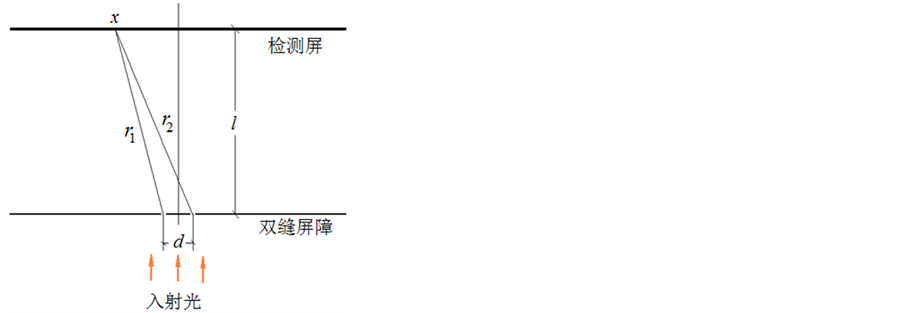1. 引言
在称为光干涉和衍射的现象中,光表现得象传统的波;而在康普顿效应和光电效应中,光又如同粒子。似乎更诡秘的是,当光的强度非常弱的下,在如双缝的实验中光同时展现似波和粒子的属性。针对此类情形,费曼称:“……这事处在量子力学的核心。实际上,它包含着唯一的秘密”[1] 。依据量子力学,光由光子组成;光子是一种量子粒子,其运动由几率波描述,而在观测中显现为粒子。光子的这种二重性理解似乎可以解释任何强度光的干涉现象。然而,波粒二重性解释光的本质还遗留下波坍塌的困惑,即几率波是怎样在观测瞬间使光子呈现为粒子的。只此困惑的存在,明白表示量子理论并未提供光或光子的一个完备描述。因此,那些基于量子理论概念诠释所进行的光子奇异特性的发现或应用是值得怀疑的,它们一定在解释或仪器设备方面存在实质缺陷。本文中,我们采用光的波描述,并将光干涉正常看作波入射问题,首先我们证明,所观测的干涉图样表示接收器的散射光强度分布,而不是入射光波叠加的强度分布。接着,通过对两种光干涉典型情况的分析,我们证明传统解释导致违背能量守恒定律。我们也讨论了单光子的干涉问题。最后提出一个判决实验方案。
2. 作为波入射问题的光干涉
当两束或多束相干光投射到一个连续物质的物体或表面(下面称为接收屏或检测器),出现光的干涉现象。由于考虑光为某种波,此现象可归结为波的入射问题。对于线性问题的普通情况,标准的分析方法是将波场分解为三部分:入射波,散射波(或反射波)以及透射波。特别是,后两者的幅度和方向由入射波的特性(频率与方向)以及屏的物理特性决定。
针对两束光波干涉的情况作更仔细讨论。首先,不论将光描述为何物,以及想象它具有何种奇异特性,确知的是:一束光就是一股能量流,以有限的速度在空间传播。其次,不论光是否相干,不同光束在它们共同存在的空间中独立的传播。对于光干涉,我们可以将接收屏前的光场分解为入射部分和散射(反射)部分。照此分解,显然,入射部分必定不存在任何方面的变化,包括强度的分布也不会有任何变化;而散射部分,由入射光和接收屏的特性共同确定,则显示出干涉图样。实际观察中,干涉图样出现在入射光落在接收屏后,当然由散射光形成,这几乎就是无需论证的事实。若接收器为一光电器件,事实更加明了。
是否有可能象量子理论正统解释的那样,干涉图样形成于入射几率波落到接收屏的瞬间?此种波坍塌猜想毫无意义,因为它永远不可能验证。应用具有有限时间分辨率的检测设备只能观测入射波场或光波落在接收屏后的光场。特别对于干涉,由于接收屏对干涉图样的形成起到不可或缺的作用,常规的检测方法还无法检测入射光场。然而,按照波叠加的解释,干涉图样指的是入射场,这不符合事实。此外,波解释还导致违背能量守恒定律,以下通过两个典型例子予以证明。
3. 两束光的干涉
为方便讨论,我们仍遵从波描述和解释:两束光若满足相干条件,在它们同时投向接收屏时将产生干涉。假设采用经典标量波描述,在接收屏上的总强度给出为:
 (1)
(1)
其中I表示光强度,下标0,1和2分别表示叠加束,波束1和波束2; 表示相对相位移。量子理论对干涉图样的解释采用几率波描述为:
表示相对相位移。量子理论对干涉图样的解释采用几率波描述为:
 (2)
(2)
其中 是几率波复幅,
是几率波复幅, 是一束光中所有光子的几率密度;下标意义与前相同。对于光干涉的解释,量子力学与经典波理论没有本质的不同,所以(2)与(1)应当等价。搁置量子力学解释导致的非实在性,假设光子为客观存在的运动粒子。给定光频率
是一束光中所有光子的几率密度;下标意义与前相同。对于光干涉的解释,量子力学与经典波理论没有本质的不同,所以(2)与(1)应当等价。搁置量子力学解释导致的非实在性,假设光子为客观存在的运动粒子。给定光频率 ,一束光的强度将为
,一束光的强度将为 。其中,
。其中, 为光子密度(单位体积光子数目),
为光子密度(单位体积光子数目), 为普朗克常数,
为普朗克常数, 为光速。通过(2)两边乘以
为光速。通过(2)两边乘以 可见,(2)与(1)可以等效。据此,无需区分光的经典波描述或几率波描述。在下述讨论中,所称的波可指两者中任一种,我们也只考虑(1)。
可见,(2)与(1)可以等效。据此,无需区分光的经典波描述或几率波描述。在下述讨论中,所称的波可指两者中任一种,我们也只考虑(1)。
按照(1),由于 随接收屏上的位置的变化,总的强度随之改变,呈现出干涉图样。问题是,由于干涉导致光强度或光子数目的重新分布,能量是否还能守恒?为解决此疑惑,我们假设两束光强度相同,并且有相同的截面,以及在各自在截面上有常数相位移。还有,假设采用某种方法使它们投射到接收屏的光斑面重合,且整个截面上两者具有常数相位差。这样,我们将获得一个强度均匀的光斑。问题是,此强度将随相位差变化。特别是,当
随接收屏上的位置的变化,总的强度随之改变,呈现出干涉图样。问题是,由于干涉导致光强度或光子数目的重新分布,能量是否还能守恒?为解决此疑惑,我们假设两束光强度相同,并且有相同的截面,以及在各自在截面上有常数相位移。还有,假设采用某种方法使它们投射到接收屏的光斑面重合,且整个截面上两者具有常数相位差。这样,我们将获得一个强度均匀的光斑。问题是,此强度将随相位差变化。特别是,当 为0时,强度将为单个光束强度的4倍,或总的光功率经干涉后增加了一倍;而当
为0时,强度将为单个光束强度的4倍,或总的光功率经干涉后增加了一倍;而当 为
为 时,合成的光强度为0。这些表示能量不守恒,或光子的生成或湮灭。
时,合成的光强度为0。这些表示能量不守恒,或光子的生成或湮灭。
一般情况下,干涉区内的相位差不为常数,而是对不同位置在0到 范围变化,形成明暗程度不同的纹理组成的干涉图样。通常倾向于认为,由相消干涉减少的能量将会由相长干涉的能量补偿,而维系总的能量不变。明显地,并不存在这样的机制,因为不同位置的干涉完全独立进行计算。虽然如此,下面我们还是通过双缝干涉的能量计算作另一验证。
范围变化,形成明暗程度不同的纹理组成的干涉图样。通常倾向于认为,由相消干涉减少的能量将会由相长干涉的能量补偿,而维系总的能量不变。明显地,并不存在这样的机制,因为不同位置的干涉完全独立进行计算。虽然如此,下面我们还是通过双缝干涉的能量计算作另一验证。
4. 双缝干涉
双缝实验布局如图1所示。其中,d为两缝的间距,l为屏障与观测屏的距离,x是观测屏上的坐标。
为使证明方便,需要作一些不影响最终结论的近似假设。这些假设有:双缝无限长,所以从它们发出的光波可以考虑成柱面波;特别地,假设每条缝发出的柱面波具有均匀波幅度,即波的幅度与圆柱角度无关。因而,若沿着缝单位长度的光功率为 ,缝隙位置的波幅度将为
,缝隙位置的波幅度将为 。从而,接收屏上的光功率可以通过将屏上干涉强度分布积分得出。
。从而,接收屏上的光功率可以通过将屏上干涉强度分布积分得出。
假设在两条缝处的光波初始相位为零,则到达接收屏x位置的两个波分别为:
 (3)
(3)
 (4)
(4)
其中 为光的角频率,
为光的角频率, ,
, ,以及
,以及 。
。
将(3)和(4)代入(1)给出叠加的强度:

Figure 1. Double slit experiment
图1. 双缝实验
 (5)
(5)
对(5)关于时间求平均,得出平均强度为
 (6)
(6)
此表达式给出接收屏上观测到的一个稳定的强度分布。
能量守恒要求 ,或者,(6)中花括号中项积分等于常数4π。然而,这是不可能的,因为积分实际上是参数l和d的函数。这表面能量不守恒。
,或者,(6)中花括号中项积分等于常数4π。然而,这是不可能的,因为积分实际上是参数l和d的函数。这表面能量不守恒。
实际上,每条缝的波幅肯定与圆柱角有关,但这明显不影响最终结论。虽然证明基于经典波描述,一般认为这不包含具有明显量子特征的情况,但波强度取统计平均值操作适合任何强度的光束,因此结果对于强度极弱的光干涉也一定成立。
5. 单个光子干涉吗?
狄拉克早就注意到采用几率波叠加解释光子干涉会导致违背能量守恒定律。在涉及光子通过某种干涉仪时,他表示,不能认为从一束光束得到的各个分光束中具有独立的一定数目的光子。理由是,若使两个分光束进行干涉,“我们就会要求一分光束中的一个光子能够与另一分光束中的一个光子进行干涉。一些情况下,两个光将相互湮灭,而另一些情况下将产生四个光子。这违背能量守恒。”为避免此种情况,狄拉克断言“每个光子只与自身干涉,两个不同光子决不发生干涉”[2] 。然而,两个不同光子观测到能够干涉,如[3] 。此事实清楚表明应用几率波解释呈现粒子特性的干涉现象也导致违背能量守恒定律。
那么,若两个光子能够干涉,单个光子仍自行干涉吗?答案是否定的。因为光束由光子组成,并且分类为相干光和非相干光。若单个光子能够自行干涉,则任何光束都会是相干光,且光束的相干宽度的概念也没有意义。显然,相干概念只对两个不同的光子,依据其频率和相位的相对关系才能定义,绝不可以对单个光子定义。即使按照狄拉克的断言,依据量子理论,若单光子可以自行干涉,仍不能避免其两个波分量可能通过全相消干涉而自行湮灭的情况,这种情况可以出现在图2所提议的实验中。
然而,已经有单光子干涉的实验观测报道,如[4] 。作为光子奇异性质之一,应该归于单光子的辐射和接收技术的不成熟[5] 。一方面,在原理上光源很可能倾向成对辐射光子,如实验中的认为的线偏振单个光子实际可为一对时间差难以区别的、自旋相反的光子。另一方面,采用光电倍增器件计数的检测设

Figure 2. Scheme of experimental test
图2. 判决实验方案
备,其光子数分辨率远达不到可以区分实验意义上瞬间接收到一个光子还是若干个光子。所以,技术上并不能保证观测到单光子干涉,又因为与光的相干属性冲突,可以断言单光子干涉并未真正观测到过,且永远不会观测到。同样由于上述原因,文献所宣称的对单光子的操控是难以置信的。值得指出的是,与狄拉克的断言一致,量子光学中仍以单个光子自身干涉为基本观点[6] 。
其它宣称对量子(包括光子)奇异特性的观测,也有类似忽视或刻意规避技术缺陷的情况。一般而言,检测装置的光子数目分辨率、同步、解耦、信噪比等都有可能对所称的观测成为致命缺陷。比如,由于检测装置的时间分辨率的限制,观测仪器不可能记录瞬时事件,但常有文献宣称观测到量子物体瞬间出现在两个不同地点或瞬间以两种不同形式出现。
实际观测装置的时间与空间分辨率的限制确实误导观测结论。设想如果早有时空分辨率足够高数字摄像机用来观测干涉图样。针对光子密度的具体情况,采用足够高的帧频,则观测到每幅图像会是光斑点分布。据此,光的粒子本性或许更早得到确定,经典的波描述或许不会出现。
6. 实验检验方案
在第3节中,对于两光束的干涉我们作了一些理想化假设。若假设的情况可以实现,无疑是最强有力的验证。相应的实验方案如图2所示。在此实验中,激光束经过扩束,再分光为两个强度相等的子束,然后经过两根光纤维后,投射到接收屏进行干涉。为了得到均匀强度的干涉光斑,在一子束的光路中插入一个相位补偿器调节其横截面上的相位分布,以使在接收屏上两子束具有常数相位差。
采用此装置,改变一根光纤的长度,就可以置两子束的相位差为合适值,产生全相消干涉或全相长干涉;依据波叠加的传统解释,原光功率将消失或倍增。此实验中光强度可弱至光子一个一个发射,从而出现单个光子湮灭的情况。
由于相位补偿的复杂性,所提议的实验不一定能达到理想的结果。实际上干涉图样近似到能明显判断能量不守恒就可以,这对于及其弱光的情况容易实现:首先采用光子计数测量激光的单位时间的生成的光子数目,再测量检测屏的光子计数,比较两个计数就可以作出判断。如果象早期物理学家惯常那样,也可以将所提议的方案看作一个思想实验,从而作出推断。
7. 讨论
现在,采用比例符号替代(1)中的等号,我们就有散射光强度相对分布的表达式。干涉现象传统解释应该来自关于普通光入射现象的经验,此情况下散射光强度或光电流强度与入射光强度成正比。但在干涉情况下,并没有这种简单关系,此时,散射光强度为零并不意味入射光强度为零。
我们会疑惑,为何散射光强度的分布会通过入射光的波描述且简单叠加来计算。要解决此问题,首先必须将干涉现象正常地考虑为一种界面现象,它由入射光子和检测屏的原子体系的相互作用导致。显然用光的波描述无法进行此种相互作用的分析。文献[7] 基于对光的粒子本质属性假设所作的光干涉解释是具有启发意义的,不仅其直观符合常理,还与量子理论中有定论的部分相融洽。按照新的解释,没有接收屏的参与,光束是不可能自行干涉的。若光子本质为粒子,光束之间当然不可能干涉。
值得关注的是,关于量子粒子的新图像可应用于量子力学问题。例如,一维势阱[8] ,两电子的原子系统[9] ,所得到的结果会涵盖量子力学结果中与实验完全相符的那部分。